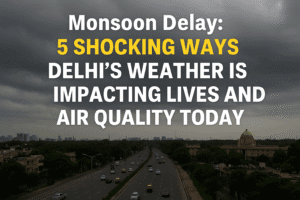Monsoon Delay: 5 Shocking Ways Delhi’s Weather Is Impacting Lives and Air Quality Today
Delhi remains suspended in meteorological limbo—clouds gather daily, temperatures stay unexpectedly mild (26-38°C), and the air quality improves (AQI 80), yet the monsoon stubbornly withholds its arrival despite repeated forecasts. Residents experience deceptive relief: mornings bring sweater-weather coolness, but evenings echo with thunder that rarely delivers substantial rain. The IMD confirms unusual atmospheric patterns—southeasterly winds and converging pressure systems—are defying typical monsoon progression.
While the delay strains farmers and water reserves, silver linings emerge: cleaner air offers respiratory respite, and cloud cover shields the city from extreme heat. Forecasts predict light rain and thunderstorms through July 2, but the absence of weather alerts underscores lingering uncertainty. As neighboring states face flooding, Delhi’s prolonged wait highlights nature’s unpredictability—a reminder that urban comfort hinges on forces beyond human control.
Key Insight: This atmospheric tension reflects climate’s growing caprice—where delayed rains paradoxically deliver cleaner air yet heighten ecological anxiety, proving nature operates on its own schedule.

Delhi woke to another morning of deceptive coolness on Friday—a bittersweet reprieve from typical June heat. While temperatures hovered at a manageable 26–38°C, the real story unfolded overhead: thick monsoon clouds gathering like unkept promises. For residents, it’s become a daily ritual—glancing skyward, smelling the petrichor-laced air, yet feeling the first drops remain just out of reach.
Why the Delay Matters
The India Meteorological Department (IMD) confirms what every Delhiite senses: the monsoon is late, and its hesitation defies predictions. Despite three days of yellow alerts and forecasts assuring arrival “within 24 hours” earlier this week, only scattered drizzles have materialized. Meteorologists point to shifting wind patterns—southeasterly flows battling atmospheric troughs—but for farmers, commuters, and heat-weary citizens, it’s a test of patience with tangible consequences:
- Agricultural anxiety: Delayed rains threaten crop schedules in surrounding regions
- Water reserves: Critical for replenishing depleted reservoirs
- Psychological toll: The collective longing for monsoon’s cleansing relief after summer
Silver Linings in the Clouds
Amidst the waiting, tangible benefits emerge:
- Air Quality Rebound: Friday’s AQI of 80 (“satisfactory”)—Delhi’s cleanest air this month—thanks to moisture-trapping clouds and winds dispersing pollutants.
- Natural Cooling: Cloud cover suppresses extreme heat, making 38°C feel manageable compared to 45°C peaks earlier this month.
- Thunderstorm Buffer: Forecast gusty winds (30-50 kmph) could prevent prolonged waterlogging if rains intensify.
The Week Ahead: Guarded Optimism
The IMD maintains a rain-ready forecast through July 2:
- Pattern: Cloudy skies with light-to-moderate rain and thunderstorms
- Timing: Evening/night storms likely, bringing temporary relief
- No Alerts: Despite predictions, no formal warnings issued—reflecting forecast uncertainty
Meanwhile Across North India
While Delhi waits, neighboring states brace for impact:
- Himachal Pradesh: Flash flood alerts after heavy rains
- Punjab/Rajasthan: “Heavy to very heavy” rainfall expected
- Regional Contrast: Highlights monsoon’s uneven advance across the subcontinent
The Human Takeaway
Delhi’s weather isn’t just meteorological data—it’s a city holding its breath. The pleasant mornings feel like nature’s apology for the delayed monsoon, while improved air quality offers partial consolation. Yet beneath the calm, there’s palpable tension: Will the skies finally break open, or is this another false dawn?
For now, Delhiites navigate a paradox: grateful for cooler days and cleaner air, yet eyeing the horizon for the real transformation only the monsoon can bring. The coming week remains a test of nature’s timing—and the city’s resilience.
This “almost-monsoon” phase reveals how Delhi’s urban experience hinges on natural rhythms. The delay underscores climate unpredictability, while the cleaner air during limbo shows how quickly urban pollution can disperse—a lesson for future environmental action.
You must be logged in to post a comment.